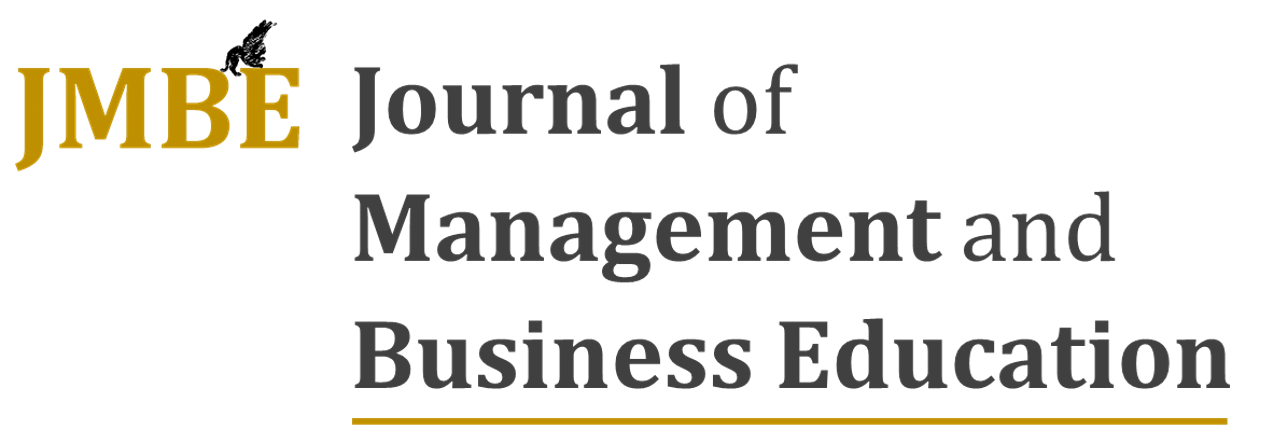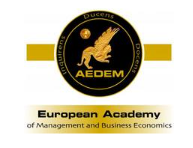Artificial intelligence to predict loyalty to university
DOI:
https://doi.org/10.35564/jmbe.2019.0003Keywords:
artificial intelligence, bayesian networks, loyalty, universityAbstract
Due to the loss of competitiveness of public institutions of higher education this research analyzes the visual identity, communication, behavior, corporate culture and image as predictors of loyalty in a public institution of higher education. For the analysis of the data, the Bayesian network's method is used. The results show that artificial intelligence has a predictive capacity of loyalty. Finally, research indicates a series of implications for the survival of these institutions.
Downloads
References
Albert, S., & Whetten, D. A. (1985). Organizational identity. Research in Organizational Behavior, Vol 7, 263-295.
Ali, F., Zhou, Y., Hussain, K., Nair, P. K., & Ragavan, N. A. (2016). Does higher education service quality effect student satisfaction, image and loyalty? A study of international students in Malaysian public universities. Quality Assurance in Education, 24(1), 70-94.
https://doi.org/10.1108/QAE-02-2014-0008
Baker, M. J., & Balmer, J. M. T. (1997). Visual identity: trappings or substance? European Journal of Marketing, 31(5/6), 366-382.
https://doi.org/10.1108/eb060637
Beerli, A., Díaz, G., & Pérez, P. J. (2002). The configuration of the university image and its relationship with the satisfaction of students. Journal of Educational Administration, 40(5), 486-505.
https://doi.org/10.1108/09578230210440311
Brown, R. M., & Mazzarol, T. W. (2009). The importance of institutional image to student satisfaction and loyalty within higher education. Higher Education, 58(1), 81-95.
https://doi.org/10.1007/s10734-008-9183-8
Cervera, A., Walesska, M., Iniesta, M. Á., & Sánchez, R. (2011). Un enfoque de stakeholders para la configuración de las universidades como centros de formación a lo largo de la vida de los individuos: aplicación a los egresados. European Journal of Management and Business Economics, 20(4), 97.
Chapleo, C. (2015). Brands in higher education: Challenges and potential strategies. International Studies of Management & Organization, 45(2), 150-163.
https://doi.org/10.1080/00208825.2015.1006014
Coelho, P. S., Rita, P., & Santos, Z. R. (2018). On the relationship between consumer-brand identification, brand community, and brand loyalty. Journal of Retailing and Consumer Services, 43, 101-110.
https://doi.org/10.1016/j.jretconser.2018.03.011
Diez-Martin, F. (2018). Dónde estamos: Una introducción a la educación en los negocios. Journal of Management and Business Education, 1(1), 1-10
https://doi.org/10.35564/jmbe.2018.0001
Desrochers, S., Andreassi, J., & Thompson, C. (2004). Identity Theory. Organization Management Journal (Palgrave Macmillan Ltd.), 1(1), 61-69.
https://doi.org/10.1057/omj.2004.14
Downey, S. M. (1986). The relationship between corporate culture and corporate identity. Public Relations Quarterly, 31(4), 7-12.
Fundación BBVA-Ivie. (2017). Evolución de la universidad privada y resultados universitarios. Esenciales, 20.
Grant, R. M. (1999). The resource-based theory of competitive advantage: implications for strategy formulation. In Knowledge and strategy (pp. 3-23). Elsevier.
https://doi.org/10.1016/B978-0-7506-7088-3.50004-8
Grant, R. M. (2004). Dirección Estratégica: Conceptos, técnicas y aplicaciones. Madrid: Thomson-Civitas.
Grant, R. M., Fernández, Z., Gómez, J. D. L., & Navarro, J. R. (2006). Dirección estratégica: conceptos, técnicas y aplicaciones.
Han, H. (2012). The relationship among corporate culture, strategic orientation, and financial performance. Cornell Hospitality Quarterly, 53(3), 207-219.
https://doi.org/10.1177/1938965512443505
Hemsley-Brown, J., Melewar, T. C., Nguyen, B., & Wilson, E. J. (2016). Exploring brand identity, meaning, image, and reputation (BIMIR) in higher education: A special section. Elsevier.
https://doi.org/10.1016/j.jbusres.2016.01.016
Ivy, J. (2001). Higher education institution image: A correspondence analysis approach. The International Journal of Educational Management, 15(6/7), 276-282.
https://doi.org/10.1108/09513540110401484
Jo Hatch, M., & Schultz, M. (1997). Relations between organizational culture, identity and image. European Journal of Marketing, 31(5/6), 356-365.
https://doi.org/10.1108/eb060636
Jones, R., & Kim, Y.-K. (2011). Single-brand retailers: Building brand loyalty in the off-line environment. Journal of Retailing and Consumer Services, 18(4), 333-340.
https://doi.org/10.1016/j.jretconser.2011.02.007
Martínez, N. O., Carabel, T. C., & del Castillo Feito, C. (2018). Legitimacy and Reputation of Organizations: Their Relationship with Management Systems and Financial Performance. In Organizational Legitimacy (pp. 141-157). Springer.
https://doi.org/10.1007/978-3-319-75990-6_9
Melewar, T. C., & Akel, S. (2005). The role of corporate identity in the higher education sector: A case study. Corporate Communications: An International Journal, 10(1), 41-57.
https://doi.org/10.1108/13563280510578196
Melewar, T. C., & Skinner, H. (2018). Defining and delimiting the scope of the Corporate Identity construct. The Marketing Review, 18(2), 115-129.
https://doi.org/10.1362/146934718X15333820910138
Munuerea, J. L., & Rodríguez, A. I. (2012). Estrategias de marketing: un enfoque basado en el proceso de dirección. Esic Editorial.
Ravichandran, T., Lertwongsatien, C., & Lertwongsatien, C. (2005). Effect of information systems resources and capabilities on firm performance: A resource-based perspective. Journal of Management Information Systems, 21(4), 237-276.
https://doi.org/10.1080/07421222.2005.11045820
Schlesinger, W., Cervera, A., & Calderón, H. (2014). El papel de la confianza, la imagen y los valores compartidos en la creación de valor y lealtad: aplicación a la relación egresado-universidad. Revista Española de Investigación En Marketing ESIC, 18(2), 126-139.
https://doi.org/10.1016/j.reimke.2014.06.001
Schmidt, K. (1995). The quest for identity: corporate identity: strategies, methods and examples. Thomson Learning.
Steiner, L., Sundström, A. C., & Sammalisto, K. (2013). An analytical model for university identity and reputation strategy work. Higher Education, 65(4), 401-415.
https://doi.org/10.1007/s10734-012-9552-1
Takaki, M., Bravo, R., & Martinez, E. (2015). La gestión de la identidad corporativa en la Universidad: análisis y consecuencias desde la perspectiva del profesorado. Revista Europea de Dirección y Economía de La Empresa, 24(1), 25-34.
https://doi.org/10.1016/j.redee.2014.05.001
Villafañe, J. (2004). La buena reputación: Claves del valor intangible de las empresas. Claves Del Valor Intangible de Las Empresas, 1.
Wilkins, S., & Huisman, J. (2015). Factors affecting university image formation among prospective higher education students: The case of international branch campuses. Studies in Higher Education, 40(7), 1256-1272.
Downloads
Published
How to Cite
Issue
Section
License
Copyright (c) 2023 Journal of Management and Business Education

This work is licensed under a Creative Commons Attribution-NonCommercial-ShareAlike 4.0 International License.
License terms at: https://creativecommons.org/licenses/by-nc/4.0/legalcode




